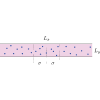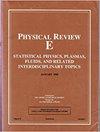Self-organization of anti-aligning active particles: Waving pattern formation and chaos
IF 2.4
3区 物理与天体物理
Q1 Mathematics
引用次数: 0
Abstract
Recently, it has been shown that purely anti-aligning interaction between active particles may induce a finite wavelength instability. The formed patterns display intricate spatiotemporal dynamics, suggesting the presence of chaos. Here, we propose a quasi-one-dimensional simplification of the particle interaction model. This simplified model allows us to deduce amplitude equations that describe the collective motion of the active entities. We show that these equations exhibit chaotic orbits. Furthermore, via direct numerical simulations of the particle's system, we discuss the pertinence of these amplitude equations approach for describing the particle's self-coordinated motions.

反排列活性粒子的自组织:挥舞图案的形成与混沌
最近的研究表明,活性粒子之间纯粹的反对齐相互作用可能会诱发有限波长的不稳定性。形成的图案显示出错综复杂的时空动态,表明存在混沌。在这里,我们提出了粒子相互作用模型的准一维简化模型。通过这个简化模型,我们可以推导出描述活动实体集体运动的振幅方程。我们证明,这些方程呈现出混沌轨道。此外,通过对粒子系统的直接数值模拟,我们讨论了这些振幅方程描述粒子自协调运动的相关性。
本文章由计算机程序翻译,如有差异,请以英文原文为准。
求助全文
约1分钟内获得全文
求助全文
来源期刊

Physical review. E
物理-物理:流体与等离子体
CiteScore
4.60
自引率
16.70%
发文量
0
审稿时长
3.3 months
期刊介绍:
Physical Review E (PRE), broad and interdisciplinary in scope, focuses on collective phenomena of many-body systems, with statistical physics and nonlinear dynamics as the central themes of the journal. Physical Review E publishes recent developments in biological and soft matter physics including granular materials, colloids, complex fluids, liquid crystals, and polymers. The journal covers fluid dynamics and plasma physics and includes sections on computational and interdisciplinary physics, for example, complex networks.
 求助内容:
求助内容: 应助结果提醒方式:
应助结果提醒方式:


